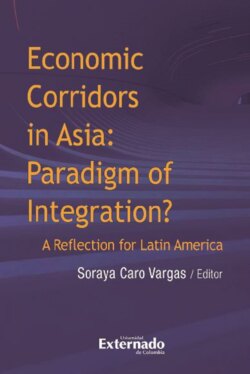Читать книгу Economic corridors in Asia : paradigm of integration? A reflection for Latin America - Varios autores - Страница 6
На сайте Литреса книга снята с продажи.
FOREWORD
ОглавлениеGlobal geopolitics has shifted dramatically over the last thirty years. After the vanishing expectations of a unipolar international system led by the United States, China has gained an increasingly dominant role in areas as innovative as quantum computing, robotics and artificial intelligence.
In the ‘non-digital’ dimension, the eastern superpower has made gigantic investments in its Belt and Road Initiative, which include the development of a massive network of highways, industrial centers, harbors, pipelines and bridges, among many other works of infrastructure. These investments allow for the connection of more than 60 countries worldwide, guaranteeing China’s energetic security, easier conditions for trading goods and services and, perhaps more importantly, a significant influence in the political and economic events of the world.
States with political regimes as diverse as those of Russia and India are part of this growing network; in various cases, in exchange for the benefits associated with being part of it, major concessions were made. By way of illustration, Sri Lanka and Pakistan, among others, given their lack of capacity to pay for some of the works, have agreed to forfeit control of specific areas of their territories.
The new game that arises under these circumstances calls for creativity in devising new models of cooperation between states, companies, citizens and the like. That is, traditional forms of association between rich and poor countries, for instance, must be thought of in a different format: the profits derived from the relationship must be clearly evident to all the actors. Similarly, historical advantages associated with geographical conditions that were explained by so-called ‘spheres of influence’, must be revisited, as new forms of connectivity – both physical and digital – are shifting at a speed not seen before.
South-south cooperation, as well as the exchange of knowledge and experience between actors who have not traditionally been leaders in their fields, is expected to play an increasingly critical role in the years to come. As in the case of concessions in sovereignty, the nature and breadth of the nation state could also be in question, insofar as deeper interests of key actors – those in power, the private sector, as well as marginalized communities – could determine modes of association that were not thought possible a few years ago.
There is a wide variety of opportunities for countries all around the world, and Latin America is not the exception to this; the success of China and India in bringing millions of people out of poverty and destitution is an experience that is appealing to many policy makers in different latitudes, despite the many other remaining challenges. These countries have recently grown at formidable rates, and it has resulted in better living conditions for large sectors of their societies. Compared to the challenges faced in the West by policies that could not prevent the collapse of the economic systems of some countries, and convulsed political systems, the policies adopted in that part of the world seem substantially more resilient.
Nevertheless, all this comes with a catch (caveat?). The emphasis on “the East model”, and particularly that of China, is not on liberty or on the protection of rights, but on having ‘the right government’. This makes some in the West uncomfortable when addressing the inevitability of a new paradigm in the international global order but, at the same time, makes the discussions about the opportunities and implications of it more urgent.
‘Asian Economic Corridors: Paradigms of Integration? A Reflection for Latin America’ is a comprehensive study aimed at addressing some of the most challenging questions of this new reality: What is the reach of the new silk road for the global south in terms of capital flows? What is its impact on regional integration strategies in the global south? Which lessons for Latin America can be learnt from the experience of other regions’ relationships with China? What opportunities in terms of development of infrastructure does this new reality have in store for Latin American countries? What are some of the costs?
The emphasis of the book on the corridors, not only illustrates the fast developments in infrastructure and connectivity initiatives coming out of Asia, but also the implications they have for topics as diverse as foreign policy, integration programs, public discourse and the adoption and contagion of new production strategies, among others.
By bringing together an important number of scholars from both, multiple disciplines and different regions, this book offers a thorough analysis of the challenges and opportunities posed by the changing global order resulting from the efforts led by China.
This is also a timely book. The deteriorating leadership in the West demands opening the public arena for discussions that cover a wide range of topics, from new models of growth and development to the opportunities and risks associated with them. These are precisely some of the discussions the authors of this book bring to the table, and the ones that will be at the frontline of political economy discussions in the near future.
JULIÁN ARÉVALO
Dean, School of Economics
Externado de Colombia University
